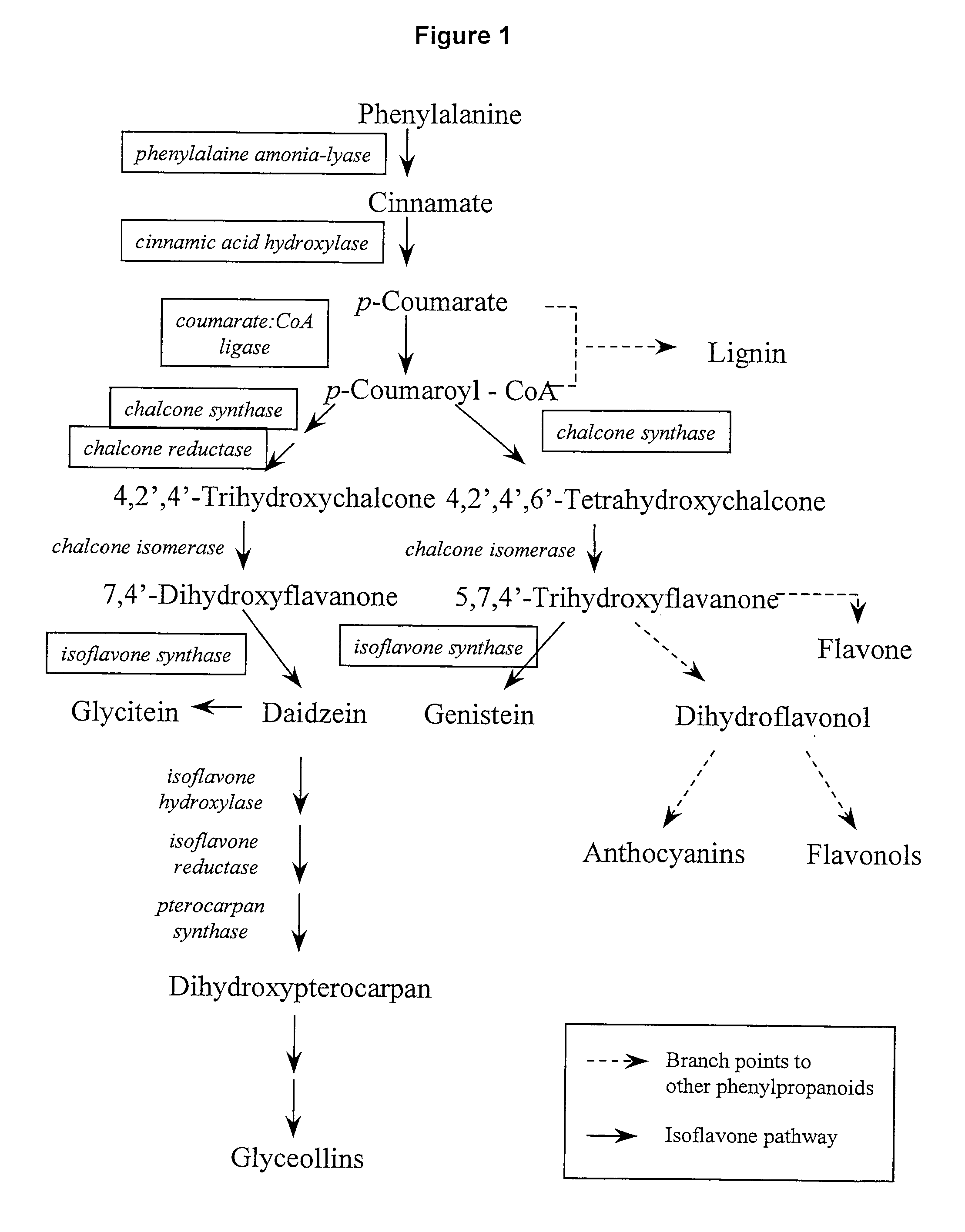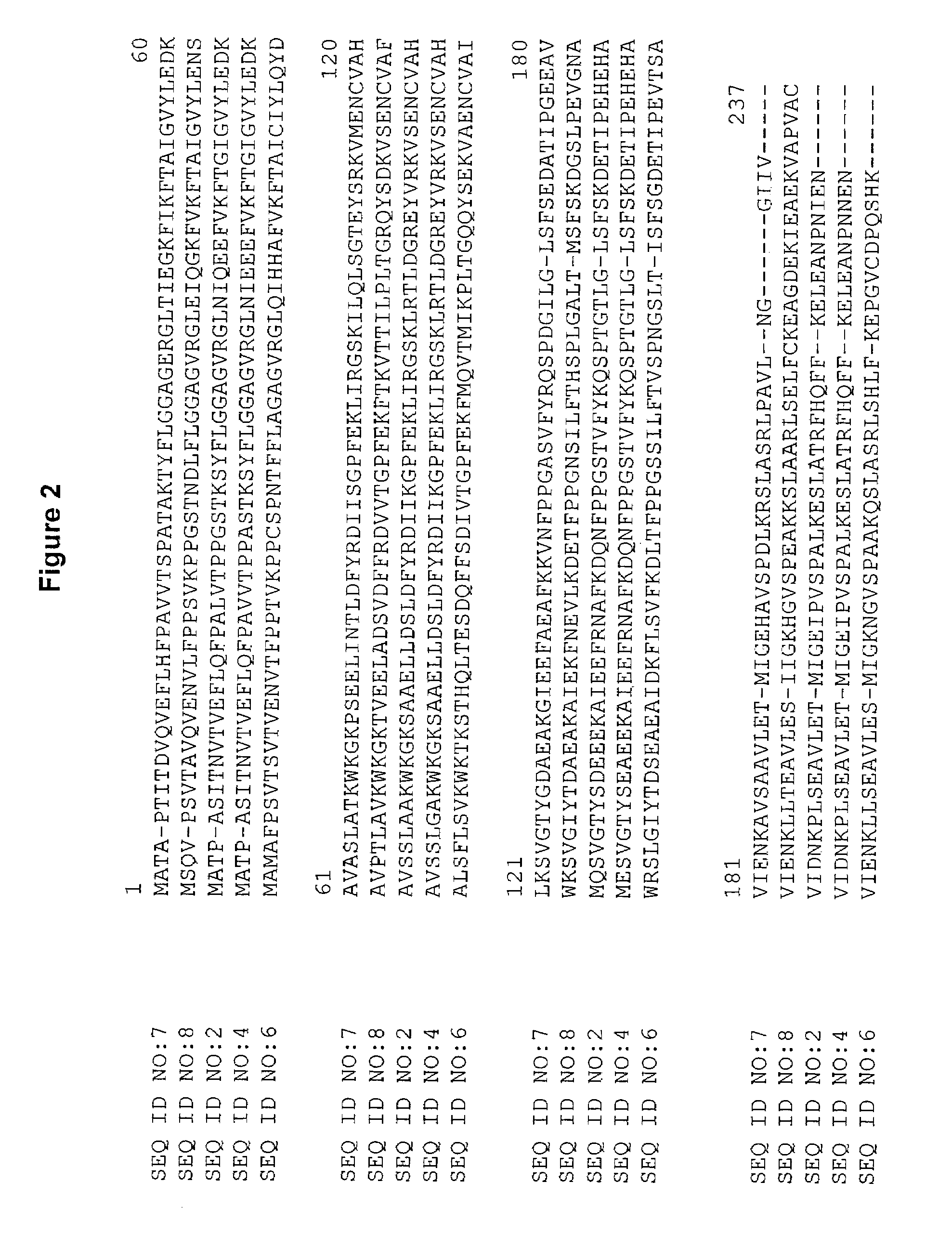Chalcone isomerase
a technology of isomerase and chalcone, which is applied in the field of plant molecular biology, can solve the problems of affecting the variable content of isoflavones in soybean seeds, and it is difficult to develop soybean lines with consistently high levels of isoflavones
- Summary
- Abstract
- Description
- Claims
- Application Information
AI Technical Summary
Benefits of technology
Problems solved by technology
Method used
Image
Examples
example 1
Composition of cDNA Libraries; Isolation and Sequencing of cDNA Clones
[0092]cDNA libraries representing mRNAs from various soybean (Glycine max L.) tissues were prepared. The characteristics of the libraries are described below.
[0093]
TABLE 2cDNA Libraries from SoybeanLibraryTissueClonesrc2cSoybean (Glycine max) 8 Day Old Rootsrc2c.pk001.k1Infected With Cyst Nematodesls1cSoybean (Glycine max) Infected Withsls1c.pk018.k17Sclerotinia sclerotiorum Myceliumsah1cSoybean (Glycine max) Sprayed Withsah1c.pk002.f8Authority ™ Herbicide
[0094]cDNA libraries may be prepared by any one of many methods available. For example, the cDNAs may be introduced into plasmid vectors by first preparing the CDNA libraries in Uni-ZAP™ XR vectors according to the manufacturer's protocol (Stratagene Cloning Systems, La Jolla, Calif.). The Uni-ZAP™ XR libraries are converted into plasmid libraries according to the protocol provided by Stratagene. Upon conversion, cDNA inserts will be contained in the plasmid vect...
example 2
Identification of cDNA Clones
[0099]cDNA clones encoding chalcone isomerase were identified by conducting BLAST (Basic Local Alignment Search Tool; Altschul et al. (1993) J. Mol. Biol. 215:403–410; see also the explanation of the BLAST alogarithm on the world wide web site for the National Center for Biotechnology Information at the National Library of Medicine of the National Institutes of Health) searches for similarity to sequences contained in the BLAST “nr” database (comprising all non-redundant GenBankT™ CDS translations, sequences derived from the 3-dimensional structure Brookhaven Protein Data Bank, the last major release of the SWISS-PROT protein sequence database, EMBL, and DDBJ databases). The cDNA sequences obtained in Example 1 were analyzed for similarity to all publicly available DNA sequences contained in the “nr” database using the BLASTN algorithm provided by the National Center for Biotechnology Information (NCBI). The DNA sequences were translated in all reading f...
example 3
Characterization of cDNA Clones Encoding Chalcone Isomerase
[0101]The BLASTX search using the sequences from clones listed in Table 3 revealed similarity of the polypeptides encoded by the cDNAs to chalcone isomerase from Phaseolus vulgaris (NCBI General Identifier No. 3041652; SEQ ID NO:7) and Vitis vinifera (NCBI General Identifier No. 1705761; SEQ ID NO:8). Shown in Table 3 are the BLAST results for sequences encoding an entire protein derived from an FIS, a contig, or an FIS and PCR (“CGS”):
[0102]
TABLE 3BLAST Results for Sequences Encoding PolypeptidesHomologous to Chalcone IsomeraseNCBIGeneral Identifier No.BLASTCloneStatus(SEQ ID NO:)pLog Scoresrc2c.pk001.k1CGS304165276.52(SEQ ID NO: 7)sls1c.pk018.k17CGS304165277.40(SEQ ID NO: 7)sah1c.pk002.f8CGS170576175.40(SEQ ID NO: 8)
[0103]The nucleotide sequence of clone src2c.pk001. k1 is shown in SEQ ID NO:1. The amino acid sequence deduced from nucleotides 62 through 742 of SEQ ID NO:1 is shown in SEQ ID NO:2. The nucleotide sequence of...
PUM
| Property | Measurement | Unit |
|---|---|---|
| temperature | aaaaa | aaaaa |
| temperature | aaaaa | aaaaa |
| temperature | aaaaa | aaaaa |
Abstract
Description
Claims
Application Information
 Login to View More
Login to View More - R&D
- Intellectual Property
- Life Sciences
- Materials
- Tech Scout
- Unparalleled Data Quality
- Higher Quality Content
- 60% Fewer Hallucinations
Browse by: Latest US Patents, China's latest patents, Technical Efficacy Thesaurus, Application Domain, Technology Topic, Popular Technical Reports.
© 2025 PatSnap. All rights reserved.Legal|Privacy policy|Modern Slavery Act Transparency Statement|Sitemap|About US| Contact US: help@patsnap.com


